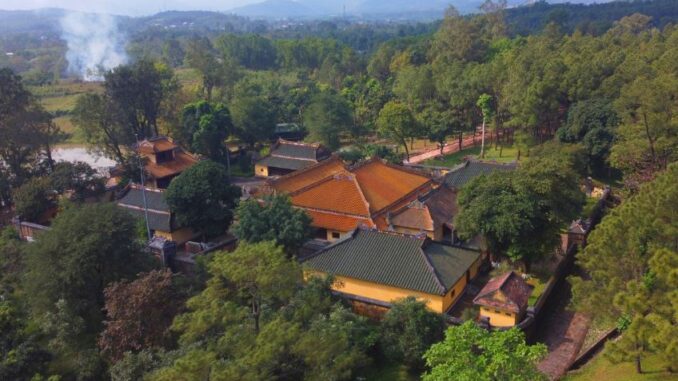
THUA THIEN – HUE – The complex of tombs of King Dong Khanh, the ninth king of the Nguyen Dynasty, has just been completely restored and started selling entrance tickets.

Tu Lang is located on Cu Si mountain and Ho Thuan Son hill, Thuy Xuan ward, Hue city, is the resting place of King Dong Khanh (1864-1888). King Dong Khanh ascended the throne in 1885 in the context of the fall of Hue citadel, King Ham Nghi and his official Ton That Thuyet left Hue to go to Tan So to call for the Can Vuong movement against the French.
Seeing that his father’s mausoleum, Kien Thai Vuong Nguyen Phuc Hong Cai, did not have a shrine, King Dong Khanh ordered the Ministry of Public Affairs to build a nearby Truy Tu Palace to bring the tablet to worship in the palace, and at the same time build a complete mausoleum for his father. However, the construction was unfinished when in 1889 the king suddenly died.
King Thanh Thai ascended the throne in the midst of a difficult economic situation, unable to build a new mausoleum for King Dong Khanh, so he changed the name of Truy Tu Palace to Ngung Hy Palace to worship. King Dong Khanh’s body was also buried on Ho Thuan Son hill, 30 meters from Ngung Hy electricity. The entire mausoleum is called Tu Lang, about 10,000 m2 wide.

The construction of the tomb of King Dong Khanh took place in many stages and lasted for nearly 35 years, through four kings, starting at the end of the reign of King Dong Khanh and completed until the reign of King Khai Dinh. Tu Lang has more than 20 large and small works, the architecture is no different from the tombs of pre-dynastic kings such as Tu Duc or Thieu Tri.
Experiencing many events, the tomb of King Dong Khanh has many damaged items, rotting wood. At the end of 2018, the Hue Monuments Conservation Center restored the overall area of the tomb of King Dong Khanh with a cost of nearly 30 billion VND. At the end of June 2022, the restoration is completed, open to welcome visitors, entrance ticket is 50,000 VND.

Ngung Hy Palace is the main area of worshiping King Dong Khanh, made of ironwood built in the same style, including 7 compartments and 2 wings, but there is an additional back hall behind. The electric roof is covered with lapis lazuli tiles, on the roof bank, the edge is decorated with five-color glaze and colored glazed terracotta.

The interior of Ung Hy Palace is richly decorated with mosaic and embossed lacquer.

The main pavilion in the center of Ngung Hy Palace is the place to place the altar to worship King Dong Khanh and the two ladies Tien Cung and Thanh Cung. The altar is made of inlaid wood, on the altar there is a white coral tree placed in a mirror cage. The boxes are richly decorated, most especially 24 paintings taken from the ancient dictionary “Two decades of filial piety”.

The main entrance door to Ngong Hy Palace is closed by a system of multi-colored panels with Western-style pictures. The door at King Dong Khanh’s mausoleum is different from other Nguyen Dynasty tombs.

The connecting road between the shrine and the tomb of King Dong Khanh is about 200 m long, restored and tiled. There is a drainage system on both sides of the road.

The area of Dong Khanh’s tomb is full of works like the tombs of pre-dynastic kings. Passing Nghi Mon, on both sides of Bai Dinh yard are two rows of statues of mandarins, martial arts, elephants and horses prostrating. Most of the area of the tomb of King Dong Khanh was built under the reign of King Khai Dinh. After ascending the throne for 3 months, King Khai Dinh sent the Ministry of Public Affairs to repair the entire mausoleum for his father.

In the middle of the tomb area is a stele house built in the style of a quadrangle with a Thanh stone stele 3 m high, 1.45 m wide, and 0.6 m thick. The stele is engraved on two sides, with the content “Thanh Duc Than Cong” written by King Khai Dinh praising his father’s merits.

King Dong Khanh’s tomb is square, 1.6 m high, surrounded by Huyen Cung with three walls built of bricks and mortar. The roof is carved with the sun, the four corners are carved with dragons and the word Tho.

Although the ticketing door has been opened, some items such as the door system have not been completed. Taking advantage of a sunny day, workers clean Nghi Mon iron frame to prepare for decoration.

The tomb area of Kien Thai Vuong Nguyen Phuc Hong Cai in Cu Si mountain is about 50 meters from the tomb of King Dong Khanh. He was the father of three consecutive emperors of the Nguyen Dynasty including Kien Phuc, Ham Nghi, and Dong Khanh, and was the ancestor of King Khai Dinh and the great-grandfather of King Bao Dai.
Photo: Internet
